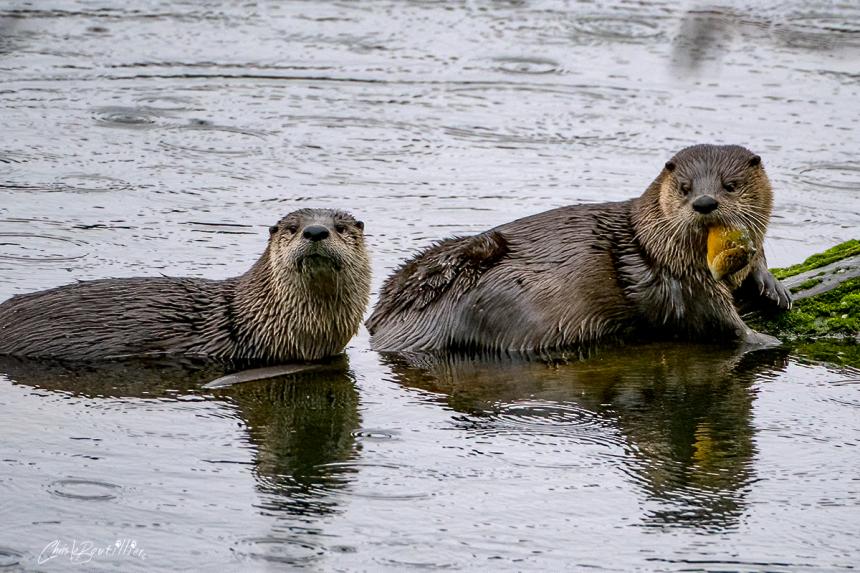River otters are sometimes mistaken for their much larger seagoing cousin, the sea otter. However, sea otters are acclimated to salt water, and come to shore only for occasional rest periods and to give birth. In comparison, river otters can be found in fresh, brackish, or salt water, and can travel overland for considerable distances.
Description and Range
Physical description
River otters have long, streamlined bodies, short legs, webbed toes, and long, tapered tails—all adaptations for their mostly aquatic lives. Their short thick fur is a rich brown above, and lighter, with a silvery sheen, below. Adult male river otters average 4 feet in length, including the tail, and weigh 20 to 28 pounds. Female adults are somewhat smaller than males.
Geographic range
Although seldom seen, river otters are relatively common throughout Washington in ponds, lakes, rivers, sloughs, estuaries, bays, and in open waters along the coast. In colder locations, otters frequent areas that remain ice-free in winter—rapids, the outflows of lakes, and waterfalls. River otters avoid polluted waterways, but will seek out a concentrated food source upstream in urban areas.
Living with wildlife
Facts about Washington River Otters
Food and Feeding Habits
- River otters are opportunists, eating a wide variety of food items, but mostly fish. River otters usually feed on 4- to 6-inch long, slowly moving fish species, such as carp, mud minnows, stickle backs, and suckers. However, otters actively seek out spawning salmon and will travel far to take advantage of a salmon run.
- River otters can smell concentrations of fish in upstream ponds that drain into small, slow moving creeks, and will follow the smell to its origin, even in urban areas.
- River otters also eat freshwater mussels, crabs, crayfish, amphibians, large aquatic beetles, birds (primarily injured or molting ducks and geese), bird eggs, fish eggs, and small mammals (muskrats, mice, young beavers).
- In late winter, water levels usually drop below ice levels in frozen rivers and lakes, leaving a layer of air that allows river otters to travel and hunt under the ice.
- River otters digest and metabolize food so quickly that food passes through their intestines within an hour.
Den Sites
- River otters use dens for giving birth and for shelter from weather extremes. Birthing dens are lined with small sticks, shredded vegetation, and other available material.
- Den sites include hollow logs, log jams, piles of driftwood or boulders, and abandoned lodges and bank dens made by nutria or beaver
- .Dens are well hidden; those located at the water’s edge will have an entry far enough below the surface to prevent it from being seen and/or frozen shut.
- River otters also den under boathouses, duck blinds, and other human structures up to ½ mile away from water
Reproduction and Family Structure
- River otters have what is called delayed implantation; the fertilized egg does not attach to the uterine wall for a period of time after breeding. Thus, gestation ranges from 285 to 375 days.
- Two to four pups are born March through May.
- Young otters begin playing at four weeks of age and learn to swim at about seven weeks of age. When eight to ten weeks of age, the pups begin exploring beyond their den and are introduced to solid food.
- In late fall, the pups leave to establish their own territories. During this time, wandering youngsters are seen far from water, traveling on land between lakes, ponds, and from one stream drainage to another.
- The basic social group for river otters is a female and her offspring. (Before and after breeding, male otters usually lead solitary lives.)
Mortality and Longevity
- Essentially safe from predators while in water, river otters are more vulnerable when they travel on land. Predators take mostly young river otters and include coyotes, bobcats, domestic dogs, cougars, and bears.
- Humans trap river otters to control fish predation in private ponds and commercial fish hatcheries and to prevent damage to private property. The most significant impacts on river otter populations include reduced water quality from chemical pollution and soil erosion, and stream-bank habitat alteration by developments.
Viewing River Otters
River otters are active day and night; around humans they tend to be more nocturnal. Otters spend their time feeding and at what appears to be group play. They also dry their fur, groom themselves, and mark their territory by vigorously scratching, rubbing, and rolling on the ground. River otters are active year round, and, except for females with young in a den, are constantly on the move. They tend to follow a regular circuit that is covered in one to four weeks. Males can travel 150 miles within a particular watershed and its tributaries in a year. A family may range 10 to 25 miles in a season.
To observe river otters, sit quietly on a high place (a bridge, overhanging bank or tree, or pier) above a known feeding area, trail, or slide. Find an angle from which you can avoid surface glare. A pair of polarized sunglasses and binoculars is useful. River otters are wary and their hearing and sense of smell are well developed. However, they are fairly nearsighted and they may not notice you if you stay still.
Never instigate a close encounter with river otters. They have been known to attack humans, and females with young are unpredictable.
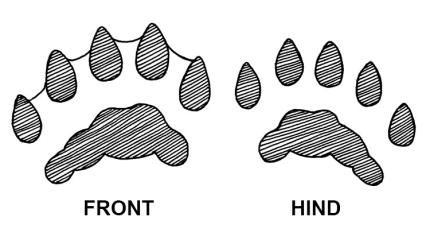
Trails and Tracks
When traveling on land river otters walk, run, or bound. Bounding is their fastest gait. When bounding, the front and hind feet are brought toward each other causing the back to arch and the tail to be lifted off the ground. Otters make trails along the edges of lakes, streams, and other waterways. Trails often lead from one cove to another across a small peninsula, or alongside shallow rapids. Trails are 6 to 7 inches wide and may lead to slides or dens. Look for tracks in soft mud, damp sand, or fresh snow.
Slides
Slides are a common sign of river otter presence and there are often several in a river otter’s home range. Slides are about 1 foot wide and located at water’s edge—frequently on islands in lakes, or in openings under bushes or brambles along creeks and streams. Slides are made in grass, dirt, sand, or snow. There is often a trail from the water’s edge to the slide.
Droppings
River otters thoroughly chew their food, so their droppings contain only fine bits of fish scales, bones, and shells. The texture is oily, the smell fishy. Droppings are left on prominent spots at the water’s edge, along trails, and near dens. Fresh river otter droppings are shapeless, slimy, and green; they darken with age.
Calls
River otter sounds include chirps (similar to a marmot), growls, whines, and, when alarmed, an explosive hah!
Preventing conflict
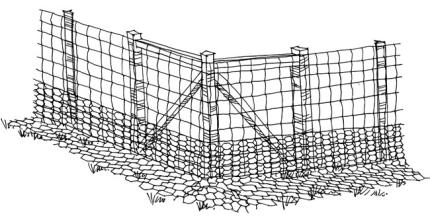
River otters are often blamed for preying on wild game fish, particularly trout. Nevertheless, studies indicate that the bulk of the river otter’s diet consists of non-game fish species.
However, river otters—particularly families containing young pups in spring—occasionally cause severe problems in fish hatcheries and private ponds. Otters also den under houses, decks, and other structures near water, and the smell of their droppings and discarded food remains can be unpleasant.
Eliminate access to feeding sites and other areas. Because river otters have heavy bodies and aren’t jumpers, a 4-foot high fence constructed with 3-inch mesh wire can keep them out of an enclosed area, such as where fish or aquaculture activities are concentrated. Because river otters are strong, fences should be sturdy and extend 6 inches below the surface to prevent otters from pushing under the fence. Alternatively, include a wire apron on the animal side of the fence to prevent otters from entering from underneath
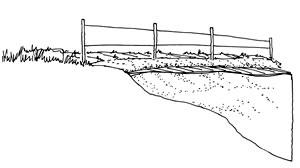
A double-wire electric fence, with wires set 6 and 10 inches above ground will also deter river otters. Such a fence can stand alone, or supplement an existing perimeter fence. A single wire can be used around docks and houseboats.
River otters are resourceful and will thoroughly investigate fence lines to find a way into a food source. They are known to use abandoned animal burrows as routes under fences. So, inspect fences regularly to make sure river otters have not dug or pushed their way under or worked their way over them.
Provide fish with hiding places. Give fish safe places to hide by constructing sturdy hiding places on the bottom of ponds using cinder blocks, ceramic drain tile, wire baskets made from leftover galvanized fencing, or upside-down plastic crates held in place with heavy rocks. In larger ponds, attach a group of cut conifer trees to a heavy anchor on the bottom of the pond.
Eliminate access to convenient denning sites. Close potential entries under porches, houses, sheds, and other structures with ¼-inch mesh welded-wire (hardware cloth), boards, or other sturdy material. Aluminum flashing, or aluminum or stainless-steel hardware cloth is recommended in saltwater areas since galvanized materials quickly corrode.
Eliminate noxious odors. Commercial odor-eliminators can be used to remove the smell of otter droppings and other debris under structures. Such products are available through hospital supply houses, drugstores, pet stores, and from the Internet using the keywords “Pest Control Supplies.” If the smell is really bad, the beams and other areas under the structure may have to be cleaned with a bleach solution (1½ cups of household bleach in 1 gallon of water). Be very careful of fumes.
River Otter in or Under Buildings
Occasionally a river otter will find a suitable den site in or under a building. Otters normally occupy a den site for only two or three consecutive nights. However, during the mating and nesting season, females are attracted to warm, dry, dark, easily defended areas, and will remain longer if the setting remains favorable.
You may choose to let otters occupy an area, such as under an outbuilding, if they don’t pose a problem. Should you choose to remove the animals, a wildlife control company can be hired (call your local Fish and Wildlife office for a current list of contacts), or you can complete the process yourself using the steps below. (For detailed information, see Evicting Animals from Buildings.)
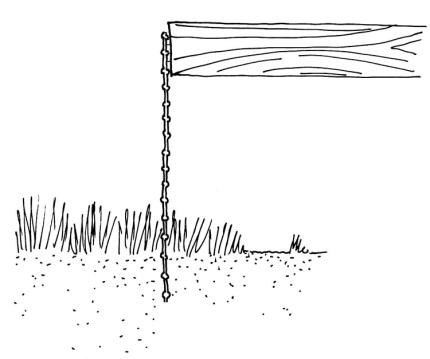
- Seal all openings except the main entrance used by otters. Use sturdy wire mesh (1/4-inch hardware cloth or similar materials) to screen vents near ground level in houses and other structures. Tightly seal holes in foundations or under porches to prevent otters from entering (Fig. 7).
- To determine entry points, you can use "tracking patches" of a fine layer of sand, flour, or dust placed at suspected entrances. Wadded up newspaper lightly stuffed into the entry hole also works great. Otters will push the paper out of the way when exiting.
- After dark, when the otter has left seeking food they will leave tracks at the den entrance. Inspect the powder or the dislodged newspaper for exiting otter tracks.
- Once a otter has left the building, immediately seal the entrance with a hardware cloth "one-way door" (Fig. 8). (You will not want to permanently exclude at this point, not being sure of the number of otters present.) The one-way door can be made from 1/4 -inch hardware cloth that is attached over the opening, and hinged at the top and left loose on the other 3 sides. It should be larger than the opening so that it cannot swing inward. The otter will push it open to leave, but cannot re-enter.
- Put a layer of flour on the inside and outside of the door after the one-way door has been installed for two to three nights. Any footprints in the flour should be outside the door with none inside. This means the otter is out. If you have any doubt, then smooth out the dirt on both sides of the door with your hand or a tool, reapply the flour and observe. Once a couple of days have gone by with no footprints, the otter is probably gone. Another way to check is to open the door and shove a few pieces of wadded up newspaper into the otter’s entrance. If the paper stays in place for two to three nights, then the otter is gone.
- Once you are sure all otters are out, permanently seal the opening.
Important Note: Be sure all animals are out before sealing up the entrance. Pay close attention and use extra caution if trying this option March through May when babies may be in the den.
To try and drive an otter away, consider harassing the animal. Lighting up the den site with battery operated flashing lights and adding a portable radio can cause a otter to seek a more suitable habitat. (For detailed information, see Evicting Animals from Buildings.)
Trapping and Lethal Control
Trapping or shooting river otters should be a last resort. Lethal control can never be justified without a serious effort to first prevent problems from recurring. Removing river otters by any means is a short-term solution since other otters are likely to move in if attractive habitat is still available. (For detailed information, see Trapping Wildlife.)
Public Health Concerns
Diseases and parasites associated with river otters are rarely a risk to humans. Canine distemper, a disease that affects domestic dogs, may be found in Washington river otter populations. Have your dogs vaccinated for canine distemper to prevent them from contracting the disease. Giardia and Cryptosporidium are also found in river otters around the Puget Sound area. These could be a public health concern for immunocompromised people. Anyone handling a river otter should wear rubber gloves, and wash their hands well when finished.
Legal Status
The river otter is classified as a furbearer (WAC 232-12-007). A trapping license and open season are required to trap river otters. A property owner or the owner’s immediate family, employee, or tenant may kill or trap a river otter on that property if it is damaging crops or domestic animals (RCW 77.36.030). No permit is necessary; however, you must notify the Washington Department of Fish and Wildlife immediately after taking a river otter in these situations. Because legal status, trapping restrictions, and other information about river otters change, contact your local state wildlife office for updates.
